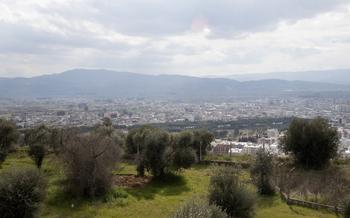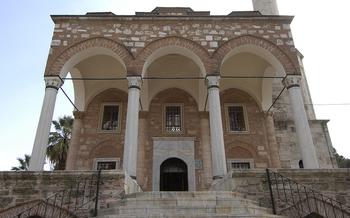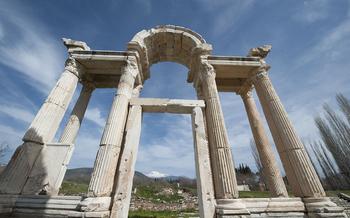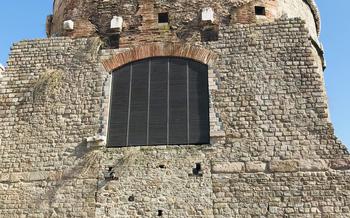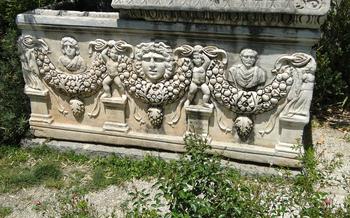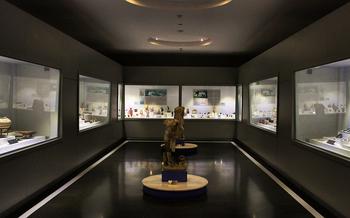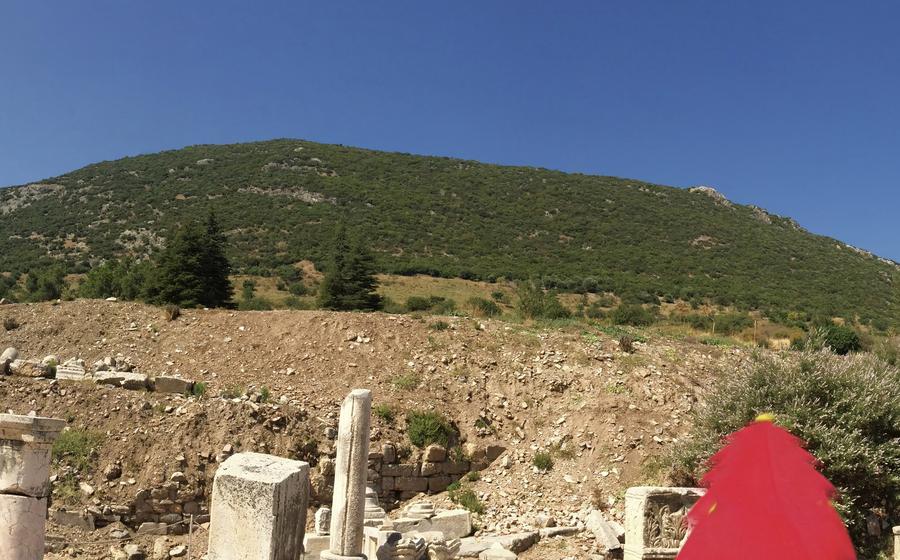
Ephesus Ancient City
- A Journey Through Time: Unveiling the Treasures of Ephesus
- The Acropolis: A Majestic Hilltop Citadel
- The Library of Celsus: A Symbol of Knowledge
- The Great Theater: A Stage for Ancient Dramas
- The Temple of Hadrian: Honoring a Roman Emperor
- The Agora: The Heart of the Ancient City
- The Terrace Houses: A Glimpse into Daily Life
- The Ephesus Museum: A Treasure Trove of Artifacts
- The Seven Sleepers Cave: A Tale of Faith and Miracles
- St. John Basilica: A Place of Worship and Pilgrimage
- The Artemisium: Honoring the Goddess of Nature
- The Isa Bey Mosque: A Blend of Cultures
- Sirince Village: A Charming Retreat
- Camel Rides: A Unique Experience
- Insider Tip: The Best Time to Visit
A Journey Through Time: Unveiling the Treasures of Ephesus
Ephesus, a city steeped in history and mythology, awaits travelers with its alluring charm. Embark on a journey through time as you explore this ancient metropolis, where every stone whispers tales of grandeur and resilience. Once a thriving port city and a major center of trade and culture, Ephesus now stands as a testament to the ingenuity and artistry of its former inhabitants. Marvel at the architectural marvels, immerse yourself in the cultural legacy, and let the spirit of antiquity transport you to a bygone era. Whether you're a history buff, an architecture enthusiast, or simply a curious traveler, Ephesus promises an unforgettable experience that will leave you in awe.
The Acropolis: A Majestic Hilltop Citadel
The Acropolis of Ephesus, a majestic hilltop citadel, stands as a proud testament to the city's glorious past. As you ascend the ancient stone steps, you'll be greeted by breathtaking panoramic views that stretch across the entire city and beyond, reaching the azure waters of the Aegean Sea. The Acropolis served as the city's religious and political center, housing several significant structures that played crucial roles in shaping Ephesus's identity.
Explore the impressive fortifications that once protected the city from invaders, marveling at the ingenuity and resilience of the ancient Ephesians. Step into the Odeon theater, a smaller version of the Great Theater, and imagine the acoustics that once reverberated through the stone seats, captivating audiences with performances and speeches.
One of the most captivating landmarks of the Acropolis is the Temple of Artemis, a magnificent structure dedicated to the revered goddess Artemis, protector of Ephesus and a symbol of fertility and nature. Although only a single column remains standing today, the sheer scale and grandeur of this ancient temple will leave you in awe, transporting you back to a time when gods and goddesses were worshipped with devotion and awe.
The Library of Celsus: A Symbol of Knowledge
Step into the grandeur of the Library of Celsus, a magnificent edifice that once housed the wisdom of ancient Ephesus. Its imposing façade, adorned with intricate carvings and statues, beckons you to explore the secrets within. As you approach, the awe-inspiring sight of this architectural marvel fills you with a sense of wonder.
Inside, the library's vast interior reveals rows upon rows of shelves, once laden with scrolls containing the knowledge of the ancient world. Imagine the scholars and philosophers who graced these halls, delving into the mysteries of science, literature, and philosophy. The sheer volume and diversity of texts housed here were a testament to Ephesus's status as a renowned center of learning.
But it is not just the quantity of books that astounds; it is the exquisite craftsmanship that adorns every corner of the library. Intricate carvings depicting mythical creatures, gods, and historical figures embellish the walls and columns, creating a visual feast that rivals the written treasures within.
In a remarkable feat of restoration, the library's façade has been painstakingly brought back to life, allowing visitors to glimpse its former glory. The vibrant colors and intricate details of the carvings transport you back in time, offering a tangible connection to the intellect and artistry of the ancient Ephesians.
The Library of Celsus stands as a testament to the enduring power of knowledge and the human spirit's relentless pursuit of understanding. Its legacy as a center of learning and a repository of ancient wisdom continues to inspire and captivate visitors from around the world.
The Great Theater: A Stage for Ancient Dramas
Among the architectural marvels of Ephesus, the Great Theater stands as a testament to the city's cultural prowess. Built in the 3rd century BC, this magnificent structure could accommodate up to 25,000 spectators, making it one of the largest theaters in the ancient world. Its impressive acoustics ensured that even those seated in the furthest rows could clearly hear the actors' voices.
The theater's stage, adorned with intricate carvings and sculptures, provided a grand platform for performances that ranged from comedies and tragedies to musical concerts and gladiatorial contests. Renowned artists from across the Roman Empire graced this stage, captivating audiences with their performances.
In addition to its theatrical significance, the Great Theater also served as a venue for political assemblies and public announcements. Here, citizens gathered to discuss important matters affecting their community, demonstrating the theater's multifunctional role in the life of ancient Ephesus.
Today, visitors to Ephesus can still marvel at the grandeur of the Great Theater. Although partially restored, the theater retains its awe-inspiring presence, allowing visitors to imagine the vibrant atmosphere and dramatic performances that once filled this ancient space.
The Temple of Hadrian: Honoring a Roman Emperor
Among the architectural marvels of Ephesus, the Temple of Hadrian stands out as a testament to the city's Roman heritage. Dedicated to the Roman Emperor Hadrian, who visited the city in 129 CE, the temple is a symbol of imperial power and architectural prowess.
Constructed in the 2nd century CE, the Temple of Hadrian is an impressive sight, featuring a well-preserved façade adorned with intricate carvings and Corinthian columns. The temple's grand design reflects the importance of Ephesus as a major city in the Roman Empire. Its location in the heart of the city, near the Agora, further emphasizes its significance.
The Temple of Hadrian served as a place of worship for the Roman gods, particularly the Capitoline Triad of Jupiter, Juno, and Minerva. Statues of these deities once adorned the temple's interior, adding to its grandeur and religious significance.
Despite the passage of time and the ravages of history, the Temple of Hadrian remains remarkably well-preserved, offering visitors a glimpse into the architectural achievements of the Roman Empire. Its impressive scale and intricate details continue to inspire awe and admiration, making it a must-see attraction for anyone visiting Ephesus.
The Agora: The Heart of the Ancient City
The agora, the bustling marketplace of Ephesus, served as the city's economic and social hub. In ancient times, it was a place where merchants from far and wide gathered to trade goods, ideas, and cultures. The agora was not merely a commercial center but also a venue for political and social gatherings. Citizens would come together to discuss important issues, attend public events, and celebrate religious festivals.
The agora's central location, adjacent to the Temple of Artemis and the Great Theater, speaks to its significance. Its spacious courtyard, surrounded by colonnaded stoas, provided shelter from the sun and rain, allowing for year-round trading activities. The stoas were lined with shops, stalls, and workshops, where merchants displayed their wares, from exotic spices to fine textiles.
In addition to its commercial function, the agora served as a social and cultural center. Public fountains and monuments adorned the square, providing a place for people to gather, relax, and exchange news. Statues of prominent citizens and deities were erected to honor their achievements and pay homage to the gods. The agora was a place where people from all walks of life interacted, creating a vibrant and diverse community.
The Terrace Houses: A Glimpse into Daily Life
Step into the Terrace Houses of Ephesus, a collection of remarkably preserved residences that offer a fascinating glimpse into the daily lives of the ancient Ephesians. These houses, built on different levels and connected by staircases, were once home to wealthy families and merchants.
As you wander through the ruins, marvel at the intricate frescoes and mosaics that adorn the walls, providing visual narratives of everyday life. Depictions of mythological scenes, banquets, and domestic activities bring the past to life, allowing you to imagine the conversations and laughter that once filled these spaces.
Pay attention to the architectural details that speak volumes about the sophistication of ancient construction techniques. The use of underfloor heating systems, running water, and even indoor plumbing demonstrates the advanced level of comfort and convenience enjoyed by the residents of these houses.
Each room tells a story of its own. The kitchens, with their stone hearths and ovens, evoke the aromas of freshly baked bread and savory meals. The bedrooms, with their alcoves and built-in beds, offer a glimpse into the private lives of the inhabitants. The dining rooms, with their elaborate decorations, hint at the social gatherings and celebrations that took place within these walls.
As you explore the Terrace Houses, you'll gain a deeper appreciation for the ingenuity, creativity, and artistry of the ancient Ephesians. These ruins are a testament to the vibrant and sophisticated society that once thrived in this remarkable city.
The Ephesus Museum: A Treasure Trove of Artifacts
Among the many wonders of Ephesus, the Ephesus Museum stands as a testament to the city's rich history and cultural heritage. Within its walls, a vast collection of artifacts, unearthed from the ancient ruins, awaits the curious visitor. Statues of gods and goddesses, intricately carved pottery, and exquisite jewelry, each piece tells a story of the city's past.
The museum's collection offers a glimpse into the daily lives of the Ephesians, from the humble pottery used in their homes to the opulent jewelry worn by the wealthy. Inscriptions and coins provide insights into the city's economy and governance, while religious artifacts shed light on the beliefs and practices of the ancient Ephesians.
The highlight of the museum is undoubtedly the Statue of Artemis, the goddess of nature and protector of Ephesus. Standing over two meters tall, the statue exudes power and grace, a testament to the skill of ancient sculptors. The museum also houses a replica of the famous Artemis Altar, a masterpiece of Hellenistic art that once stood in the Temple of Artemis, one of the Seven Wonders of the Ancient World.
The Ephesus Museum is a treasure trove of knowledge and beauty, a place where the past comes alive. As you wander through its galleries, you will gain a deeper appreciation for the ingenuity, creativity, and artistry of the ancient Ephesians.
The Seven Sleepers Cave: A Tale of Faith and Miracles
Nestled amidst the hills surrounding Ephesus, the Seven Sleepers Cave holds a special place in both Christian and Islamic traditions. According to legend, seven young men, fleeing persecution during the reign of the Roman emperor Decius, sought refuge in a cave. Miraculously, they fell into a deep slumber that lasted for centuries. When they awoke, they discovered that the world had changed dramatically, and Christianity had become the dominant religion. The Seven Sleepers' tale symbolizes the power of faith and the enduring nature of divine protection.
The cave itself is a sacred site, attracting pilgrims from around the world. Visitors can explore the cave's chambers, where the seven sleepers are said to have slept, and marvel at the intricate carvings and inscriptions that adorn the walls. The cave's serene atmosphere and natural beauty add to its spiritual significance, making it a place of contemplation and reflection.
Whether you're a history buff, a religious pilgrim, or simply someone seeking a unique and awe-inspiring experience, the Seven Sleepers Cave is a must-visit destination in Ephesus. Prepare to be captivated by its blend of history, legend, and spirituality, and leave with a renewed sense of wonder and faith.
St. John Basilica: A Place of Worship and Pilgrimage
Amidst the ruins of ancient Ephesus, the St. John Basilica stands as a testament to the city's rich religious history. Built in the 6th century AD, this impressive structure was dedicated to St. John the Evangelist, one of the twelve apostles of Jesus Christ. According to tradition, St. John spent his later years in Ephesus, where he preached and wrote the Gospel of John.
The basilica, once a magnificent edifice, has undergone several renovations and restorations over the centuries. Despite the passage of time and the ravages of history, its grandeur is still evident in its imposing ruins. The basilica features a vast central nave flanked by two aisles, separated by rows of massive columns. The apse, where the altar once stood, is adorned with intricate carvings and mosaics.
The most sacred site within the basilica is the tomb of St. John, located in a crypt beneath the altar. Pilgrims from around the world flock to this holy place to pay homage to the beloved apostle and seek his blessings. The tomb is adorned with exquisite marble carvings and inscriptions, adding to the spiritual aura of the basilica.
St. John Basilica is not just a historical site but also a place of active worship for Christians. Regular masses and religious services are held within the basilica, attracting a devoted congregation. The basilica's serene atmosphere and rich history create a unique spiritual experience for visitors, making it a must-visit destination for pilgrims and history enthusiasts alike.
The Artemisium: Honoring the Goddess of Nature
Amidst the ruins of ancient Ephesus, the Artemisium stands as a testament to the city's deep-rooted religious beliefs and its devotion to the goddess Artemis. Once one of the Seven Wonders of the Ancient World, this magnificent temple was dedicated to Artemis, the protector of nature and the hunt. Its colossal size and intricate architecture symbolized the importance of the goddess in the lives of the Ephesians.
The temple's construction began in the 6th century BC and spanned several centuries. It was designed by the renowned Greek architect Chersiphron and adorned with sculptures by some of the most skilled artists of the time. Its grandeur was such that it attracted visitors and pilgrims from across the ancient world.
Despite its destruction by fire in the 4th century AD, the remains of the Artemisium still evoke a sense of awe and wonder. The massive columns, intricate carvings, and scattered fragments of the temple's once-glorious façade hint at its former splendor.
Visiting the Artemisium is a journey back in time, a chance to connect with the ancient world and its religious beliefs. It's a reminder of the enduring power of faith and the human desire to honor the forces of nature.
The Isa Bey Mosque: A Blend of Cultures
Amidst the ancient ruins of Ephesus, the Isa Bey Mosque stands as a testament to the city's rich cultural heritage. Built in the 14th century during the reign of the Anatolian beylik of Aydın, the mosque seamlessly blends Ottoman and Seljuk architectural styles, reflecting the region's diverse history.
The mosque's exterior façade is adorned with exquisite tilework and intricate calligraphy, showcasing the artistry and craftsmanship of the period. The interior features a spacious prayer hall with elegant columns and a beautifully decorated mihrab, indicating the direction of Mecca.
The Isa Bey Mosque serves as a symbol of religious tolerance in Ephesus, where different faiths have coexisted peacefully throughout history. Its architectural harmony and serene atmosphere make it a popular destination for visitors seeking a glimpse into the city's spiritual and cultural diversity.
Sirince Village: A Charming Retreat
Nestled amidst the rolling hills of İzmir, the picturesque village of Sirince beckons travelers with its irresistible charm. A labyrinth of narrow cobblestone streets winds its way through the village, lined with quaint stone houses adorned with colorful flowers. The air is filled with the heady aroma of grapes, as Sirince is renowned for its traditional wineries.
Take a leisurely stroll through the village, admiring the well-preserved Ottoman and Greek architecture. Stop by one of the many wineries to sample the local vintages, or indulge in a traditional Turkish meal at one of the charming restaurants.
As you explore Sirince, you'll feel as though you've stepped back in time. The village has managed to retain its authentic character, despite the influx of tourism. It's the perfect place to escape the hustle and bustle of city life and immerse yourself in the tranquility of rural Turkey.
Whether you're sipping wine in a local winery, savoring a delicious meal, or simply wandering the charming streets, Sirince offers a unique and unforgettable experience. Don't miss the opportunity to visit this hidden gem during your trip to Ephesus.
Camel Rides: A Unique Experience
Embark on a unique journey through time as you explore the ancient city of Ephesus on camelback. This traditional mode of transportation offers a captivating perspective of the ruins, allowing you to traverse the cobblestone streets and immerse yourself in the history that surrounds you. Take in the breathtaking views of the surrounding landscape as you sway gently atop your camel, feeling like a true explorer of old. This memorable adventure provides a fresh and unforgettable way to experience the wonders of Ephesus, creating lasting memories that will transport you back to this extraordinary place.
Insider Tip: The Best Time to Visit
While Ephesus is a year-round destination, visiting during the shoulder season (April-May and September-October) offers a unique charm. The weather is pleasant, with warm days and cool nights, making it ideal for exploring the ancient city without the summer crowds. With fewer tourists, you can enjoy a more intimate experience, wander leisurely through the ruins, and capture stunning photographs without the distraction of throngs of people. The serene atmosphere during this time allows you to truly connect with the history and grandeur of Ephesus. Embrace the tranquility of the off-season and delve into the wonders of this ancient city at your own pace.
